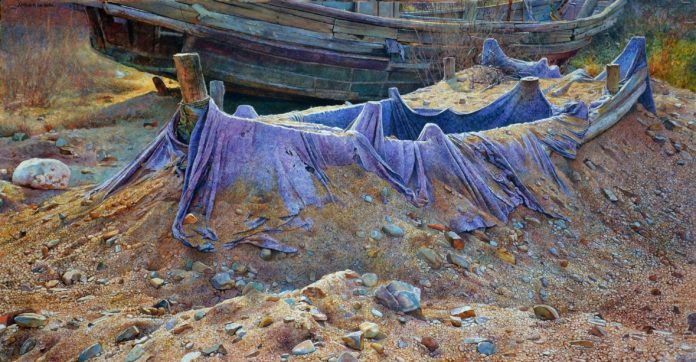
Help us congratulate Angus McEwan, a recent winner of the bi-monthly PleinAir Salon, and enjoy this exclusive Q&A with the artist, who shares his biggest challenges, his advice for others, and the answer to a common question he hears about his watercolor paintings.
The next PleinAir Salon deadline is coming soon (click here to enter today).
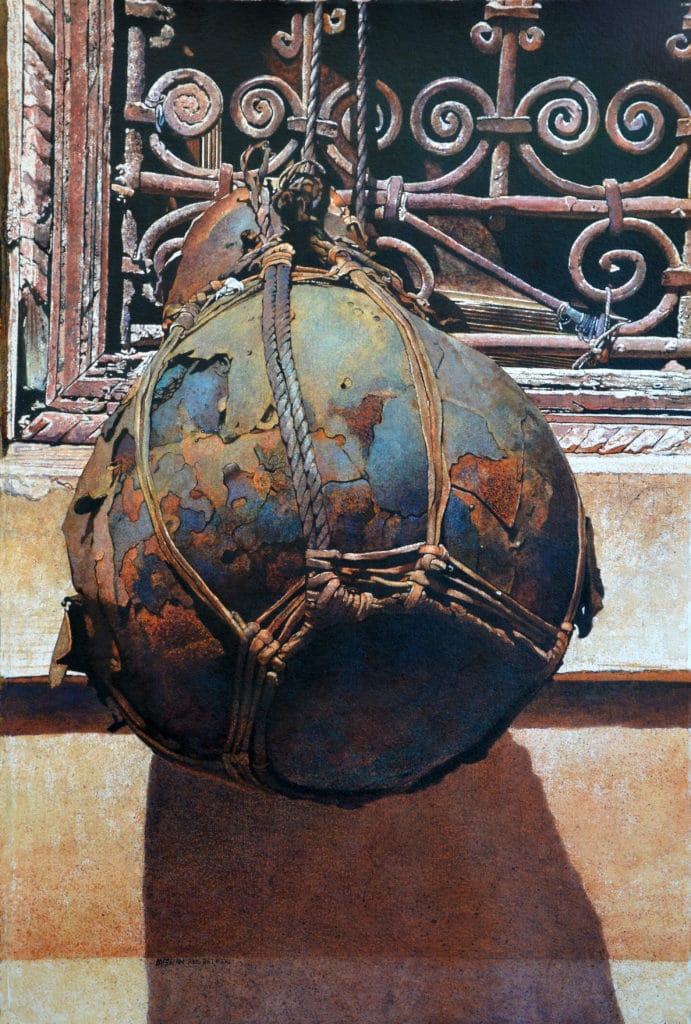
This old gourd was found tied up to a window in the souk in Marrakech. It, however, meant a lot more to me than just an interesting subject to paint. It was a stark reminder of the possible state our planet may begin to resemble if we don’t rein back the abuse we as a species are dishing out to our home. Uncared for and taken for granted, the surface layers of this gourd were delaminating and eventually it wouldn’t be fit for its purpose; the metaphor wasn’t lost on me.
Cherie Dawn Haas: Do you use watercolor en plein air? If so, what are some things you’ve learned about painting outdoors with watercolor?
Angus McEwan: I am very much a studio painter, as I do take quite some time to develop my work. As such, my plein air pieces are very much about capturing a mood or impression of a topic which will help inform my work back in the studio.
There is very much a distinct difference between my careful drawing, layer building, and thoughtful process which I have developed back in the comfort of the studio. To me, working outside is the antithesis of that. I work at speed trying to head off the movement of the sun. I battle with insects, passers-by, and traffic, conditions that are too damp, too hot, or too cold. My work is a rushed impression of my topic, created in a frenzied and energetic way in response to my subject.
So why do I do it?
Well, there is nothing quite like trying to distill a very complex environment in a simple but meaningful way. You must do this within an hour or hour and a half as the sun will have moved to pastures new and your scene will become something else. You pick up on lots of information that stays with you for quite some time in a way that doesn’t quite happen in the studio. That’s why I think working outside, where applicable, helps me back in the studio. I’m not necessarily copying the image but using the experience of working outside to help me understand what is needed while working in the studio.
The biggest issue for me, especially working in damp Scotland, is the drying aspect. I prefer to work wet on dry but when the humidity is high, and the ambient temperature is cool, then nothing will make that piece of paper dry quickly (I’ve looked at cordless hair dryers but the batteries are big and heavy). This forces me to work in a different way and one I’m never entirely comfortable with. That’s why most of my outdoor work is consigned to the plan chest or sketchbook, as it is part of the development of a painting for me. Not an end in itself but the beginning of the process.
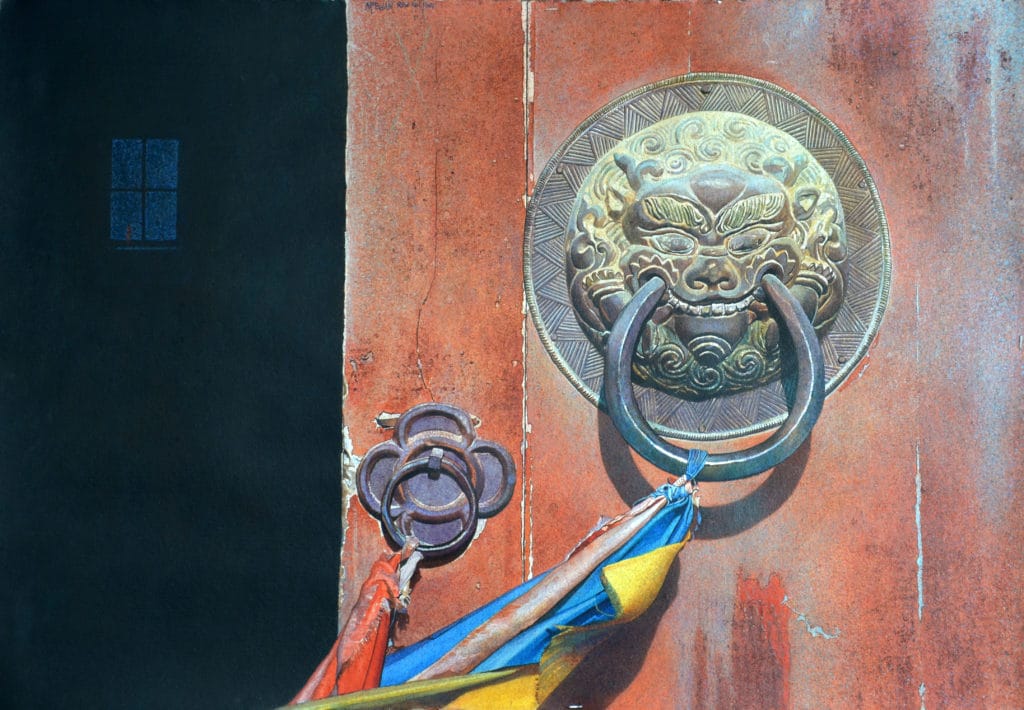
This painting is very much in the tradition of many of my pieces, and in fact I was startled to discover that I had painted something very similar after my first trip to China in 1996. I will quite often split my painting surface up into basically thirds although it is not always that simple. Most of the painted surface is taken up with an object, or door in this instance, and it allows me to experiment with surfaces and textures. The pieces of brightly colored cloth at the bottom of the painting “breeches” the division running down the painting. In the darkness a hint of a window gives a slight sensation of distance and carries the eye into an area that is primarily absent of color or substance.”
CDH: What’s a common question you hear (and the answer you give) about painting in general, or about your style or media?
AM: Is that watercolor? That’s not how watercolor should look. More often than not my work is often considered to be produced with acrylic or oil rather than watercolor, as it is either too strong tonally, too strong color-wise, or too thick. I break a few rules when working, but I like that. I love experimenting, and that is where I get the most enjoyment from, so I don’t follow the “rules” as they are applied to watercolor. If it is archivally sound, anything goes, and I will combine many things together to create my work. Enjoyment is paramount when producing artwork and that reigns supreme for me. Who cares if you use white? Some of the best watercolorists that ever used the medium did, and so do I.
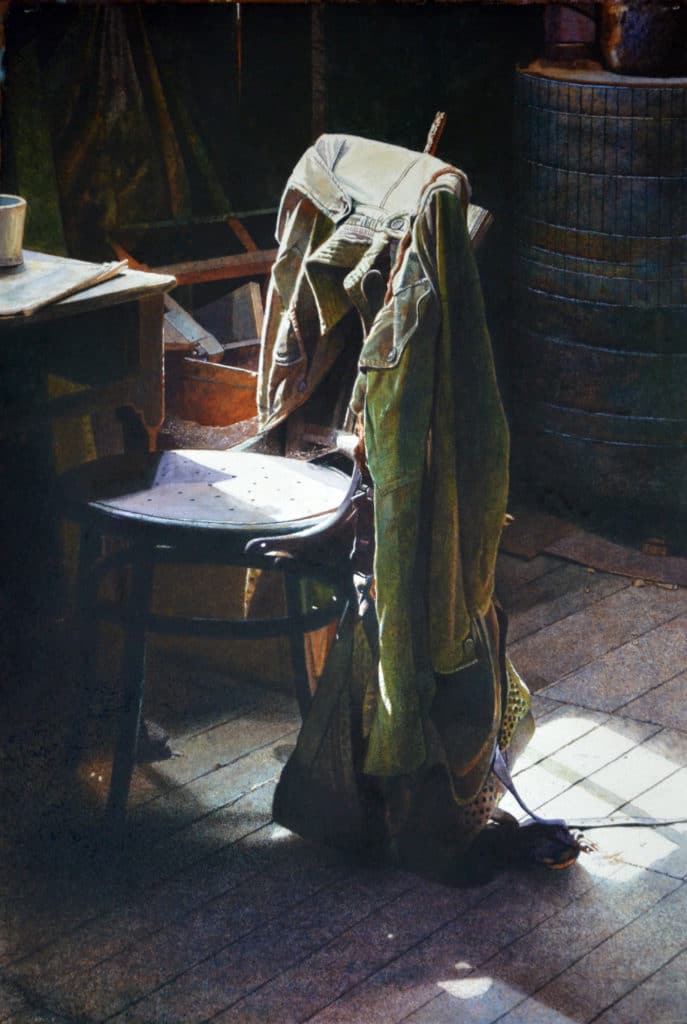
“Tea break,” a moment in time preserved for eternity, the point when someone puts their cup and newspaper down on the desk and walks out the door never to return. Why have they not returned? Why did they not come back for their coat or clean the mug or put the paper in the bin? This scene looks as if the owner of the coat will return again very soon until we realise that the coat has cobwebs arcing across it. The scene, which I happened to come across, is set in an old lumber mill in Scotland, the tools and paraphernalia stuck in the 1940s. It is a slight departure for me subject-wise, but it has been an idea which has been lingering in my thoughts for a little while. This means I’m alive to the moment when I come across it.
CDH: What’s a common artistic challenge you face, and how do you overcome it?
AM: Not enough time to do everything that needs my attention. Being an artist, for me, involves many different aspects which need tending to, like a garden (you can’t focus on cutting just the grass all the time). Unfortunately, I can’t concentrate on painting all the time, as I also commit part of my week to teaching in college. I have articles to write, emails to answer, PR to deal with, preparation for workshops, judging competitions, selecting work for shows, preparing work for exhibitions, arranging work to be collected or sent abroad, making boxes for sending work away, curating and arranging other artists’ work for exhibitions, and so on. The list is endless, and I am sure every artist is the same; you just don’t get enough time to paint.
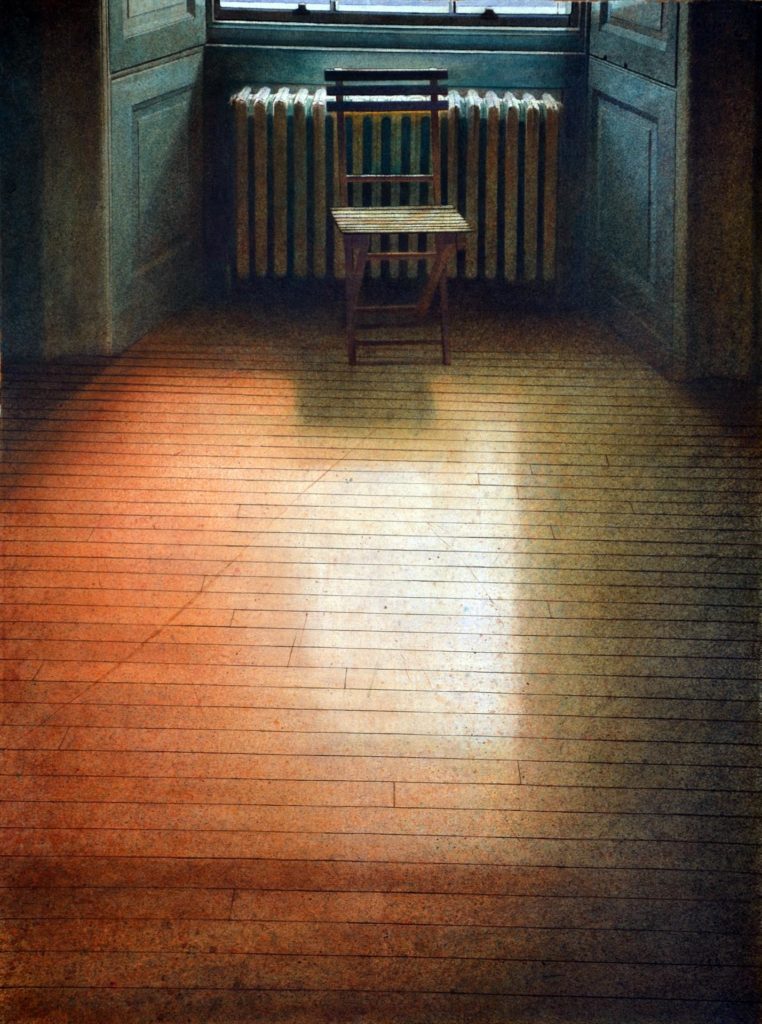
CDH: Please tell us about your winning watercolor, “Contemplation.”
AM: “Contemplation” is based on a subject I have painted many times over the years although not in this particular place. On this occasion, it is a gallery space in the botanic gardens in Edinburgh, Scotland. I love painting contre jour (against the light) and I particularly like how this creates a lot of soft unresolved areas within the painting juxtaposed with the harsh silhouette of an object against bright light. It was the softness that caused me the most problems but dry brushing and continual spraying helped me find an appropriate solution.
The painting was originally a small sketch in a sketchbook and a series of photographs were taken as an aid memoir. It was a familiar concept and therefore not much time was taken sketching out the idea. The challenge was to balance a large area where not a lot was happening against an area at the top of the painting which contained most of the largest range of colour, tone and subject. I had to repeatedly wet and soften most of the edges in the painting to create the illusion of atmosphere, this also meant my focal point was largely out of focus and suggestive. I enjoyed making this painting as it challenged me in a slightly different way to my normal subject matter.
The painting is about absent friends. An empty seat, waiting to be filled. That moment when you are alone with your thoughts wishing your friend or loved ones were present to share the experience with you.
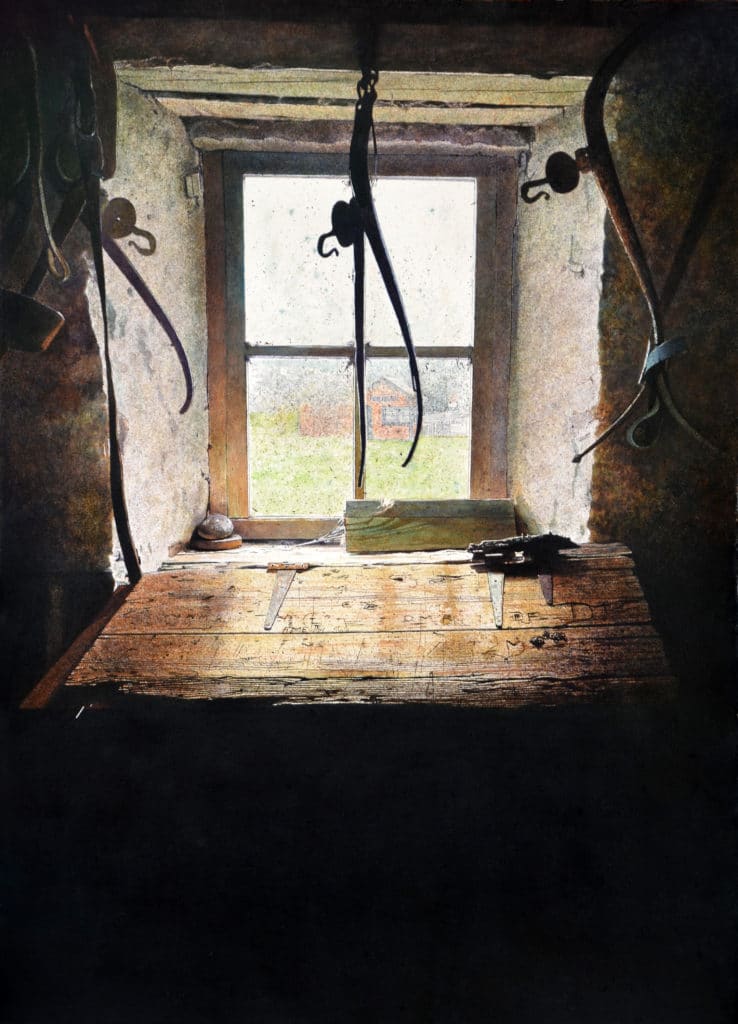
This image came from an old farm up the West coast of Scotland. There is an old writing desk sitting in front of a small dusty window, on the desk are initials and letters carved into its surface. Hanging above the window are harnesses which were obviously used on the farm amongst others farm paraphernalia attached to the wall. The challenge for me was to depict the lovely fall of light as it comes through the distorted surface of the window. It was difficult not to make the tonal range too extreme and therefore too stark. I wanted a gentler fall of light and a feeling of being in a place of its time, I therefore kept the coloring very muted and subdued. There is a hint of a brighter more colorful life outside the window but the surface holds back and softens the vibrancy. I wanted a feeling of nostalgia, somewhere lost in time, a point in history around the time after the second world war where times were less frenetic and simpler.
CDH: How did you feel when you discovered that you won first place in the August/September PleinAir Salon?
AM: I was incredibly happy and grateful to receive first place. Recognition is an important part of life but being recognized as having produced a work of art of significance is incredibly satisfying and humbling. I never take anything for granted and as such winning a prize with my work is always a fantastic moment to be celebrated.
CDH: What advice do you have for other artists who are considering entering their work?
AM: You must be in it to win it. I know a lot of artists don’t take part in competitions or juried shows because it creates a lot of angst for them. I’m of the opinion that you should try, you just don’t know what the selector will enjoy seeing. It may well be your subject matter and style of work just hits the nail on the head. I’m certainly glad I took the opportunity to take part.
CDH: Anything else you’d like to add?
AM: I would like to thank the PleinAir Salon for supporting artists across the world. By investing in artists through competitions and through articles in art magazines and in online blogs such as yours we would have an art world much diminished by a lack of backing. Without your support and recognition our work has less exposure and therefore less impact on people’s lives. Thank you!

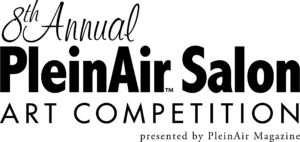
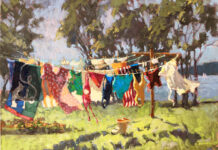
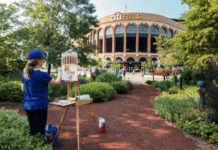

Some nice insight from an Artst that captures beauty of realism. I prefer to go with the flow of humidity, as my style changes at times. I agree with you that about one hr a d a half is all that is useful, as the lighting changes.
The very definition of en plein air artworks is to be OUTSIDE, working quickly and to adapt as the weather, lighting and other conditions change. Works created from detailed photographs and sketches in the studio(INDOORS!) later is not in the spirit of the en plein air tradition and as such should not be advanced as a plein air work. It is a stretch of the very meaning of what “en plein air” means and is all about to paint as this artists does., and call it such.
These works should be considered in my opinion to be realism and/or still life. None of the subjects of the paintings shown in this article are of the outdoors! Plein air means out of doors, in the elements. These are intricate and beautiful pieces created over time in a studio. Please don’t corrupt what the basic and true en plein air artists/painters do! We stand or sit outside in the elements painting what we see with the naked eye, adapting to changing light, shadow and conditions. That is the very definition of plein air painting. It is not sitting in a studio later after sketching and photographing the motif and then carefully over time/days creating a work of art. The outside spontaneity
is integral to the plein air experience.
This is not an opinion… this is a fact of the very meaning of what it is to paint out of doors. Certainly every plein air painter feels betrayed by the notion that an artist can use the term “en plein air” to describe their work when actually creating a work in the studio of an inside or outside motif. Works passed off as done in the exclusive and challenging style of plein air painting that are not plein air is absurd. There are just some definitions/conditions that fall in the plein air style/category….that “in studio”, from photos and sketches, even if the artist had been outside, that betray the the very core principles and meaning of “en plein air”. I disagree with the awarding or recognition of these works as PLEIN AIR. As such all true plein air painters lose their exclusive rights in competitions, shows and gallery acceptance as artists who adhere to this challenging and exclusive style of painting. We all lose when long standing terms/definitions and traditions of a painting style are ignored and corrupted. 🙁
Mr. McEwan produces spectacular artwork, but I agree with you. It is not plein air.
Hi Catherine, I hope you don’t mind me replying to your comment. I don’t call myself a PleinAir painter or indeed a Watercolourist but a painter who uses many different processes to create my work. PleinAir is part of my working process. My inability to stand at the same spot for weeks on end precludes me from carrying through my paintings to the end onsite. Many are started in front of the subject outside but completed in the studio or even hotel room (often from memory). The shroud painting (above) started in China in front of a boat but eventually took 6 months to complete- not possible to do in PleinAir the way I work not withstanding the fact I don’t live in China. Thus I find a way that works for me. I hope you understand I am not trying to pull the wool over anyone’s eyes here. It is what it is and that is a part of a whole, not the whole part.
Why do you care? Have you ever started a plein air painting, taken a photograph and finished in the studio? Watercolor is a different animal and is handled differently than oil that doesn’t take tedious drying time and glazing. The juror was alright with his means to the end. I think the work is excellent original interpretation of the scene that inspired it.
The paintings shown in this article are just wonderfully done from a compositional aspect. I love the half cup shown in Tea Break as most people would have shown a full cup sitting there. I also find it interesting that the setting for the gourd and the world seems to be in a third world setting with the iron on the windows. Is that where hope will come from??? I think the interpretation of your emotional response to the idea or subject is brilliant.
I agree that your paintings remind me of oil paintings and I think this is why they garner attention too.
Beautiful work.
I would have liked to see a couple of the plein air pieces in that wild impressionistic stage in the article.